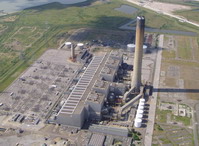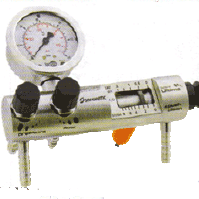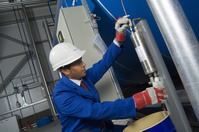 The boiler make-up water treatment plant at the Isle of Grain Power Station is refurbished
The boiler make-up water treatment plant at the Isle of Grain Power Station is refurbishedAt 30 years old, the boiler make-up water treatment plant at E.ON
 The boiler make-up water treatment plant at the Isle of Grain Power Station is refurbished
The boiler make-up water treatment plant at the Isle of Grain Power Station is refurbished JOHN CRANE Safematic has launched an enhanced version of its Safeunit seal water control system that has already been proven to increase the reliability of pumpg and process machinery while reducing water consumption levels by up to 80%.
JOHN CRANE Safematic has launched an enhanced version of its Safeunit seal water control system that has already been proven to increase the reliability of pumpg and process machinery while reducing water consumption levels by up to 80%.
The new Safeunit Ultima is designed for use in harsh operating environments where high temperature, high pressure and chemically aggressive elements are present.
This makes it ideal for extreme applications found in pulp, paper and chemical industry processes, plus a wide variety of mining and general industrial uses.
Tel: 0161 886 5993 www.johncrane.co.uk I
 Plant operators could be wasting thousands of pounds in fuel because their water treatment supplier is failing to monitor the phosphate levels of raw water for their steam systems. And the situation could get worse as water utilities strive to meet tightening European drinking water regulations.
Plant operators could be wasting thousands of pounds in fuel because their water treatment supplier is failing to monitor the phosphate levels of raw water for their steam systems. And the situation could get worse as water utilities strive to meet tightening European drinking water regulations.
According to the European Drinking Water Directive, water supplies must not exceed 25 microgrammes of lead per litre of water, reducing to 10 microgrammes from 25 December 2013. To meet these limits, water utilities commonly dose water with phosphate to inhibit lead from old pipes leeching into the water supply.
However, many steam system operators may not be taking account of these added phosphates, so are not adjusting their water treatment regime accordingly. Consequently, excessive phosphate levels could cause scaling of the internal surfaces of steam boilers, reducing their efficiency significantly.
Worker health and safety are critical in the modern industrial landscape. Industries from manufacturing to chemical processing, mining, and beyond present unique and varied hazards to employees. As these sectors evolve, so do the complexities of their associated risks and the need for more advanced breathing protection solutions for workers.
Despite thorough regulations and safety protocols across the region, several challenges persist in safeguarding industrial workers. Many facilities still rely on legacy safety apparatus that may not meet current standards or be effective against modern hazards. Such equipment can be cumbersome, reducing worker mobility and efficiency and lacking integration with contemporary safety technologies.
The absence of systems that provide real-time feedback on environmental conditions and worker health can hinder proactive hazard management. Without the correct data, it's difficult to identify and respond to emerging threats, resulting in delayed and reactive interventions. In the ideal scenario, safety teams can detect and address risks before they escalate to improve safety and reduce downtime.
How M1 SCBA Meets These Needs
The M1 SCBA by MSA Safety is a forward-thinking approach to industrial safety and breathing protection. Its customisable design allows for easy adjustments and upgrades, helping to improve safety standards without the need for complete overhauls. Constructed with chemical-resistant materials, it provides a robust barrier against hazardous substances, assisting workers in staying shielded from exposure.
Equipped with integrated monitoring capabilities, the M1 SCBA also facilitates real-time tracking of environmental conditions and equipment performance. It empowers safety teams with actionable data, enhancing situational awareness and response times.
Furthermore, the lightweight design distributes weight evenly to help reduce physical strain. Each component is designed for easy disassembly and cleaning, promoting better hygiene practices and extending the equipment's lifespan.
Discover how M1 SCBA can transform your safety protocols: link.
Safety - Latest News - RSS Feed >>